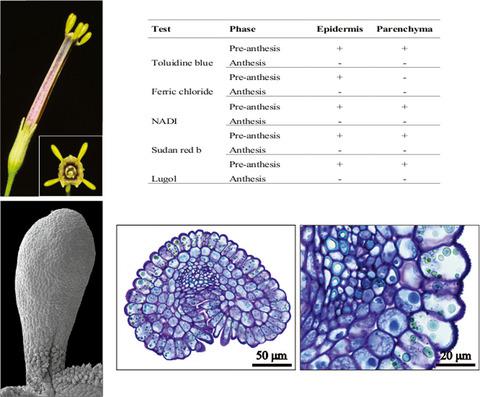当前位置:
X-MOL 学术
›
Plant Biol.
›
论文详情
Our official English website, www.x-mol.net, welcomes your feedback! (Note: you will need to create a separate account there.)
Unravelling the structure and function of the petal appendages in the tribe Schwenckieae (Solanaceae).
Plant Biology ( IF 3.9 ) Pub Date : 2019-12-13 , DOI: 10.1111/plb.13061 J O A Paucar 1 , R M S Isaias 1 , J R Stehmann 1
Plant Biology ( IF 3.9 ) Pub Date : 2019-12-13 , DOI: 10.1111/plb.13061 J O A Paucar 1 , R M S Isaias 1 , J R Stehmann 1
Affiliation

|
The tribe Schwenckieae (Solanaceae) is characterised by the presence of appendages on the corolla, a diagnostic trait for the group. These appendages constitute a median distal projection of the three-lobed petal and occur in the genera Melananthus and Schwenckia but are absent in Heteranthia. We investigated the micromorphology and anatomical structure of the appendages and lateral petal lobes of Schwenckia americana (two varieties), S. angustifolia, S. curviflora and S. novaveneciana, and Melananthus fasciculatus. We also performed histochemical tests to determine if the appendages are involved in the production of volatiles, acting as a fragrance secretory structure (osmophore). The appendages have a uniseriate epidermis, whose cells store phenolics and lipids. The parenchyma is starch-rich just prior to anthesis in all species studied. The sensory test and anatomical analyses identified scent-secreting tissues, not only in the appendages, but also in the lateral petal lobes, whose cells are papillose with a sculptured surface. The α-naphthol p-phenylenediamine (NADI) reaction detected volatile (essential oils) compounds in S. americana var. americana and S. americana var. angustifolia. We demonstrated the secretory tissues and the production of lipids in the corolla appendages of Schwenckia and Melananthus, which indicate their osmogenic function and probable scent emission to attract pollinators.
中文翻译:

揭开Schwenckieae(Solanaceae)部落花瓣附肢的结构和功能。
Schwenckieae(Solanaceae)部落的特征是花冠上有附属物,这是该群体的诊断特征。这些附属物构成三叶瓣的正中远端投影,出现在Melananthus和Schwenckia属中,但在Heteranthia中不存在。我们调查了美国的Schwenckia(两个变种),S。angustifolia,S。curviflora和S. novaveneciana和Melananthus fasciculatus的附肢和侧瓣瓣的微观形态和解剖结构。我们还进行了组织化学测试,以确定这些附属物是否参与了挥发物的生产,这些挥发物起着香料的分泌结构(渗透压)的作用。附肢有一个单性表皮,其细胞储存酚类和脂质。在所有研究的物种中,薄壁组织在开花前即富含淀粉。感官测试和解剖学分析不仅在附肢中而且在花瓣的侧瓣叶中都发现了分泌气味的组织,这些细胞的细胞是具雕塑性的乳突状。α-萘酚对苯二胺(NADI)反应检测到美国沙门氏菌中的挥发性(精油)化合物。Americana and S. americana var。桔梗。我们证明了Schwenckia和Melananthus的花冠附睾中的分泌组织和脂质的产生,表明它们的致渗透作用和可能的气味释放以吸引传粉者。美国变种 Americana and S. americana var。桔梗。我们证明了Schwenckia和Melananthus的花冠附睾中的分泌组织和脂质的产生,表明它们的致渗透作用和可能的气味释放以吸引传粉者。美国变种 Americana and S. americana var。桔梗。我们证明了Schwenckia和Melananthus的花冠附睾中的分泌组织和脂质的产生,表明它们的致渗透作用和可能的气味释放以吸引传粉者。
更新日期:2019-12-13
中文翻译:

揭开Schwenckieae(Solanaceae)部落花瓣附肢的结构和功能。
Schwenckieae(Solanaceae)部落的特征是花冠上有附属物,这是该群体的诊断特征。这些附属物构成三叶瓣的正中远端投影,出现在Melananthus和Schwenckia属中,但在Heteranthia中不存在。我们调查了美国的Schwenckia(两个变种),S。angustifolia,S。curviflora和S. novaveneciana和Melananthus fasciculatus的附肢和侧瓣瓣的微观形态和解剖结构。我们还进行了组织化学测试,以确定这些附属物是否参与了挥发物的生产,这些挥发物起着香料的分泌结构(渗透压)的作用。附肢有一个单性表皮,其细胞储存酚类和脂质。在所有研究的物种中,薄壁组织在开花前即富含淀粉。感官测试和解剖学分析不仅在附肢中而且在花瓣的侧瓣叶中都发现了分泌气味的组织,这些细胞的细胞是具雕塑性的乳突状。α-萘酚对苯二胺(NADI)反应检测到美国沙门氏菌中的挥发性(精油)化合物。Americana and S. americana var。桔梗。我们证明了Schwenckia和Melananthus的花冠附睾中的分泌组织和脂质的产生,表明它们的致渗透作用和可能的气味释放以吸引传粉者。美国变种 Americana and S. americana var。桔梗。我们证明了Schwenckia和Melananthus的花冠附睾中的分泌组织和脂质的产生,表明它们的致渗透作用和可能的气味释放以吸引传粉者。美国变种 Americana and S. americana var。桔梗。我们证明了Schwenckia和Melananthus的花冠附睾中的分泌组织和脂质的产生,表明它们的致渗透作用和可能的气味释放以吸引传粉者。


























 京公网安备 11010802027423号
京公网安备 11010802027423号